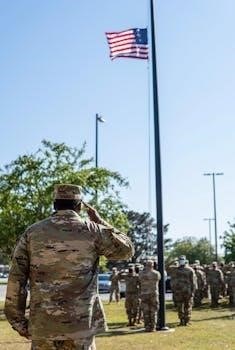the ants go marching lyrics pdf
The Ants Go Marching Lyrics PDF⁚ A Comprehensive Guide
The Ants Go Marching is a classic children’s song. This comprehensive guide will provide you with access to PDF lyrics. This fun rhyme teaches counting. It also incorporates actions. Enjoy the playful rhythm and educational elements!
“The Ants Go Marching” is a beloved children’s nursery rhyme and counting song that has captivated generations with its simple yet engaging melody and playful lyrics. This classic tune tells the story of a seemingly endless column of ants marching forward. They perform different actions along their journey. Its rhythmic structure and repetitive verses make it an ideal learning tool for young children. It helps to introduce them to basic counting skills and rhythm recognition.
The song’s origins can be traced back to the American Civil War song “When Johnny Comes Marching Home,” which provides a familiar and catchy tune that is easily adapted for children. Each verse features a different number of ants, from one to ten. It describes a humorous action performed by the “little one,” such as sucking their thumb, tying their shoe, or climbing a tree. The song’s lyrics are often accompanied by hand motions or marching movements, adding a physical element to the learning experience. This makes it a perfect activity for kindergartens, camps, and family gatherings. It fosters both cognitive and motor skills development. The downloadable PDF version offers a convenient way to access and share the lyrics, ensuring that this timeless song continues to bring joy and education to children worldwide.
Full Lyrics of the Song (Verses 1-10)

Here, you’ll find the complete lyrics to “The Ants Go Marching,” spanning all ten verses. Each verse follows a similar structure. It begins with the ants marching in a specific number, accompanied by “hurrah, hurrah!” or “Hoorah! Hoorah!” as a joyful refrain. The lyrics then describe a unique action performed by the “little one,” adding a touch of whimsy and humor to the song. Finally, the verse concludes with all the ants marching down to the ground to escape the rain, punctuated by the sound effect “Boom! Boom! Boom!”
These lyrics provide a clear and engaging way for children to learn counting. They also introduce them to simple rhyming patterns. From the first verse, where the little one stops to suck his thumb, to the tenth verse, where the little one shouts “The End!”, each verse offers a playful scenario that captures a child’s imagination. The repetitive nature of the song makes it easy for children to memorize and sing along, fostering a sense of accomplishment and musicality. The PDF version allows for easy printing and sharing. It makes it an invaluable resource for parents, teachers, and caregivers looking to share this timeless classic with the next generation. The actions associated with each verse further enhance the learning experience.
Verse 1⁚ One by One (Sucking Thumb)
Verse 1 of “The Ants Go Marching” introduces the foundation of the song’s counting structure. It sets the stage for the subsequent verses. The lyrics begin with the ants marching “one by one,” emphasizing the starting point of the numerical progression. The cheerful refrain of “hurrah, hurrah!” (or “Hoorah! Hoorah!”) is repeated. It adds to the song’s upbeat and engaging nature.
The focus then shifts to the “little one,”. The lyrics state that the “little one stops to suck his thumb.” This simple yet relatable action brings a sense of childlike innocence and familiarity to the song. It’s an action many young children can identify with. It creates a connection between the song and their own experiences. The verse concludes with all the ants marching down to the ground, escaping the rain. This is accompanied by the iconic “Boom! Boom! Boom!” sound effect. This provides a sense of resolution and anticipation for the next verse. This verse is a great starting point for learning the song. It’s repetitive structure is easily memorized. It also acts as a great first step in learning numbers. The PDF version makes learning even easier.
Verse 2⁚ Two by Two (Tying Shoe)

Verse 2 of “The Ants Go Marching” builds upon the numerical progression introduced in the first verse. The ants now march “two by two.” This emphasizes the growing count. The familiar refrain of “hurrah, hurrah!” (or “Hoorah! Hoorah!”) is repeated again. This helps maintain the song’s cheerful rhythm and engaging quality.
The focus shifts again to the “little one”. The lyrics now state that the “little one stops to tie his shoe”. This presents a relatable, everyday action that children can easily visualize. Tying a shoe is a common task for young children. It adds a sense of familiarity and practicality to the song. It also subtly promotes self-care. This verse concludes just like the first. All the ants are marching down to the ground to escape the rain. This is accompanied again by the “Boom! Boom! Boom!” sound effect. This reinforces the song’s structure and creates a sense of anticipation for the verses to come. The repetition and simple actions make it an excellent tool. It also helps to teach children about counting. The PDF version of the lyrics makes it easy for children to follow along.
Verse 3⁚ Three by Three (Climbing a Tree)
Verse 3 of “The Ants Go Marching” continues the pattern of incremental counting. It introduces the concept of “three by three”. The familiar “hurrah, hurrah!” (or Hoorah! Hoorah!) refrain occurs again. This consistent repetition provides a comforting structure for children. It allows them to anticipate and participate actively in the song.
The “little one” now pauses to climb a tree. This introduces a playful and adventurous element. Climbing a tree suggests exploration and interaction with nature. This contrasts with the more domestic action of tying a shoe in the previous verse. Again, the ants march down to the ground to escape the rain. This reinforces the established pattern. The “Boom! Boom! Boom!” sound effect is repeated, solidifying its role as a key element. The consistent structure of the song helps children learn about numbers. It also teaches about rhyming and rhythm. Using a PDF of the lyrics can help children improve their reading skills. It makes the learning process more engaging. It also provides a fun way to learn.
Verse 4⁚ Four by Four (Shutting the Door)
In Verse 4, the number of marching ants increases to “four by four.” The familiar refrain of “hurrah, hurrah!” (or Hoorah! Hoorah!) repeats. This consistent element helps children to anticipate the lyrics. It allows them to actively participate in the song. The action of the “little one” shifts to “shutting the door.”
This action suggests a sense of domesticity and security. Shutting the door implies protection from the elements. This reinforces the theme of seeking shelter from the rain. The ants continue their march down to the ground. The “Boom! Boom! Boom!” sound effect is repeated. This adds a playful and rhythmic element to the verse. Each verse helps children learn about numbers. It also introduces new actions and scenarios. The consistent structure and repetition make the song easy to remember. Using a PDF of the lyrics can enhance the learning experience. It helps children follow along with the song. They can also practice reading the lyrics. This combines music and literacy skills in a fun and engaging way.
Verse 5⁚ Five by Five (Taking a Dive)

In Verse 5, the ant colony grows. It now marches “five by five.” The repetitive “hurrah, hurrah” (or “Hoorah! Hoorah!”) continues. It reinforces the song’s rhythm. The “little one” now stops “to take a dive.” This action contrasts with previous verses. Instead of domestic or practical actions, it introduces a playful element. Taking a dive suggests a sense of adventure and fun. It adds a new dimension to the ants’ journey;
Despite the change in action, the core structure remains consistent. The ants still march down to the ground to escape the rain. The familiar “Boom! Boom! Boom!” sound effect is repeated. This repetition helps children anticipate and remember the lyrics. It also reinforces the song’s overall message. The PDF format of the lyrics is useful for visual learners. It allows them to follow along with the words. The simple rhyme scheme and repetitive structure make the song easy to learn. The song promotes early literacy skills. It also encourages participation and interaction. Each verse builds upon the previous one. It reinforces counting skills. It introduces new actions that stimulate the imagination.
Verse 6⁚ Six by Six (Picking up Sticks)
As the ants continue their march, Verse 6 introduces “six by six.” This continues the counting progression. The familiar “hurrah, hurrah” (or “Hoorah! Hoorah!”) refrain is repeated. It maintains the song’s joyful rhythm. The “little one” now pauses “to pick up sticks.” This action brings a sense of purpose. It suggests the ants are working or gathering materials. The act of picking up sticks is simple. It is relatable to children. It can be tied to outdoor activities.
The fundamental structure remains consistent. The ants proceed to march down to the ground. They seek shelter from the rain. The “Boom! Boom! Boom!” sound effect is present. It reinforces the song’s familiarity. The PDF version of the lyrics can be used in classrooms. Parents can use it at home. The song can be used to teach counting; It also teaches rhyming and simple actions. Each verse contributes to the overall narrative. The narrative is about a group of ants working together. They march toward a common goal. The song encourages group participation. It promotes physical activity through marching and actions. The repetitive nature of the song aids memory retention. It makes it accessible for young children.
Verse 7⁚ Seven by Seven (Praying to Heaven)
In Verse 7, the ants march “seven by seven.” The familiar structure of the song remains. The “hurrah, hurrah” chant is repeated, maintaining rhythm. The action shifts to a more contemplative moment. The “little one” pauses “to pray to heaven.” This adds a spiritual or reflective element. It introduces a moment of quiet amidst the marching. Praying to heaven can be interpreted in various ways; It can mean showing gratitude. It can mean seeking protection. The phrase is simple. It is accessible for children to understand.
The ants then continue their descent. They march down to the ground. They seek refuge from the rain. The “Boom! Boom! Boom!” sound effect is present. It reinforces familiarity. The PDF lyrics are useful educational resources. They aid educators in classrooms. Parents can use them at home. The song can be used to teach counting. It teaches rhythm and simple moral lessons. The verse adds depth to the song. It also encourages reflection and gratitude. Each verse contributes to the narrative. The narrative centers around unity and purpose. The ants work together. They march toward a shared goal. The repetitive nature of the song encourages learning. It fosters a sense of community.
Verse 8⁚ Eight by Eight (Rollerskating)
In Verse 8, the ants continue their march. They proceed “eight by eight”. The familiar “hurrah, hurrah” refrain echoes once more. The action introduces a playful, energetic element. The “little one” pauses “to rollerskate.” Rollerskating suggests fun and lightheartedness. It adds a whimsical touch to the marching routine. This verse breaks the monotony of the march. It shows individual expression. The image of an ant on rollerskates is amusing. It captures the imagination of children.
Following the rollerskating escapade, the ants resume their journey. They descend to the ground to escape the rain. The “Boom! Boom! Boom!” sound effect punctuates the verse. It reinforces the recurring theme of seeking shelter. The rollerskating action provides a vivid image. It enhances the song’s appeal; The PDF lyrics serve as a visual aid. They help children follow along with the song. This verse continues the pattern. It combines counting with engaging actions. The pattern is simple; It helps children learn and remember. The song remains a favorite. It is a favorite for parents and educators. It is a valuable resource. It teaches basic concepts. It also entertains children. The verses add variety. They keep children engaged.
Verse 9⁚ Nine by Nine (Checking the Time)
As the ants approach the end of their march, Verse 9 introduces a sense of anticipation. “The ants go marching nine by nine, hurrah, hurrah!” The lyrics count upward. The ants march in larger groups. The repetitive “hurrah” adds to the song’s rhythm. The “little one” performs a practical action. The ant “stops to check the time”. This action introduces a modern element. It adds a touch of realism to the whimsical march. Checking the time suggests awareness and preparation. It implies the ants have a schedule.
Following the time check, the ants continue their march. They head “down to the ground to get out of the rain”. The “Boom! Boom! Boom!” sound effect punctuates the verse. It reinforces the urgency to seek shelter. The act of checking the time contrasts. It is a contrast with the other actions. It is less whimsical. It reflects daily routines. This contrast adds depth. The verse retains the song’s playful spirit. The PDF lyrics make the song accessible. Children can easily follow along. They can engage with the counting and actions. This verse maintains the structure. Each verse builds upon the previous one. It reinforces the counting sequence. It prepares children for the final verse. The “little one” adds character. The simple actions make learning fun. The song encourages participation. It helps children develop skills.
Verse 10⁚ Ten by Ten (Shouting the End)
Verse 10 brings “The Ants Go Marching” to an exciting conclusion. “The ants go marching ten by ten, hurrah, hurrah!” This verse emphasizes completion. It highlights the final count in the sequence. The increased number of ants underscores the scale. The “little one” expresses jubilation. They “stops to shout THE END!!” This action provides a clear signal. It is a signal that the song is concluding. The shouting adds a lively and celebratory tone. It engages children. It encourages them to recognize the end.
As with previous verses, the ants march “down to the ground”. They seek to “get out of the rain”. The familiar “Boom! Boom! Boom!” effect follows. It reinforces the song’s structure. The finality of the verse is emphasized. The song also invites a sense of closure. The PDF lyrics ensure easy access. Children can follow the counting and actions. Parents and teachers appreciate this accessibility. It is perfect for group activities. This verse reinforces learning; It also makes it entertaining. The consistent structure of each verse aids comprehension. The final verse leaves a lasting impression. It reinforces the counting skills. The song encourages a sense of accomplishment. “Shouting THE END!!” promotes enthusiasm. It makes learning a joyful experience. The ants have reached their destination! The rain is no longer a threat!
The Tune’s Origin⁚ “When Johnny Comes Marching Home”

The melody of “The Ants Go Marching” has interesting roots. It is derived from “When Johnny Comes Marching Home”. This is a popular song from the American Civil War. “When Johnny Comes Marching Home” was published in 1863. Patrick Gilmore wrote both the words and music. The tune’s transition from a war song to a children’s rhyme is fascinating. It showcases music’s adaptability. It can evoke different emotions and contexts.
The upbeat and simple nature of the melody makes it suitable. It works for both marching soldiers and marching ants. The repetitive structure makes it easy. It is easy for children to learn and remember. The lyrics of “The Ants Go Marching” replace the original. The new lyrics focus on counting and actions. The familiar tune provides a sense of comfort. It is a comfortable connection to a different era. The song transforms the historical melody. It creates a new, engaging experience for young listeners. Understanding the origin adds depth. It adds depth to appreciation for “The Ants Go Marching”. The PDF lyrics become more than just words. They represent a musical transformation. Teachers can use this information. It can be used to teach history. It can also be used to teach music appreciation. The link between the two songs highlights the evolution. It highlights the evolution of folk music. It showcases its enduring appeal. The melody remains recognizable. It provides a familiar foundation. It allows children to easily engage with the new lyrics.


